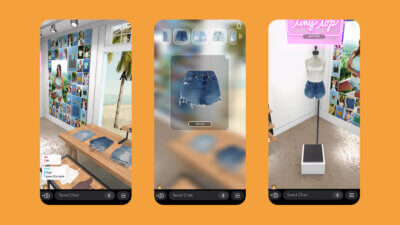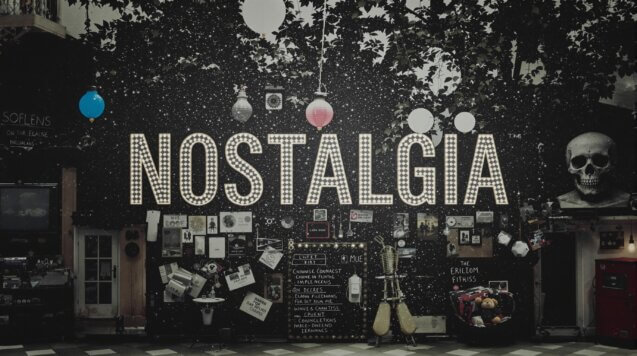Snapchat, the AR (Augmented Reality) based image and messaging application, is taking its eCommerce potential to a whole new level.
Snapchatters already love the AR capabilities of the app with Snap revealing that users are engaging with AR more than 6 billion times per day with 93% of users interested in using AR for shopping.
Snapchat’s new ‘Catalog-Powered Shopping Lenses’ allows brands to showcase an entire range of products inside one single lens. This improves functionality and eases the user experience by providing more virtual try-on options in one simple location.
What does an AR Shopping Lens look like?
When you activate Snapchat’s AR shopping lens and navigate to the brand of your choice, you will now be able to see a whole line of different products within a single Lens promotion. You won’t need to swipe to a new lens to compare products and can simply swipe between products to easily compare.
Furthermore, each item will display a small thumbnail with an image of the product against a white background, a short product description or label, the price of the product and a clickable button to bounce to the site for purchase.
The first brands to feature and use this new capability include Ulta Beauty and MAC cosmetics but over the coming months, more and more popular brands will be added to these Lenses.
How does Snapchat’s AR shopping feature work?
Snapchat has achieved this integration by directly linking the Catalog Lens feature to a company’s product catalogue. This direct connection allows for more capacity and information in product displays within the application as Snapchat will pull correct information directly from a catalogue and no middle man is required.
What are the benefits of this AR shopping feature?
By keeping the link between a Snapchat Lens and a company’s catalogue constant, Snapchat can update Lenses with further timely promotions and new deals on the fly.
Snapchat can also arm businesses with product-aligned feedback they receive in-app to the brands instantly. For example, if you spot or are informed that one product is selling like hotcakes in Snapchat, you could update your catalogue with a line specific to that product or inform your strategy however you want.
The platform itself also benefits because Snapchat can now see what products an individual user and demographic are engaging with, which will then inform their own targeted advertising systems. All of this information will be used holistically and collaboratively to improve the performance of campaigns for both Snapchat and brands using Snapchats AR shopping feature.
Are there any more changes to Snapchat AR shopping?
Yes, there are more changes but they are brand-relevant. For example, Snapchat is also updating its Lens Web Builder Tool so brands have new templates and tools to use when setting up their own AR portal for customers.
Snapchat said in a statement: “We’ve now made it so brands can generate a commerce Lens in as fast as two minutes and Beauty brands can do so in just a few clicks. At launch, this quick click accessibility in Lens Web Builder will be available to Beauty brands and will roll out to other product verticals in the coming months. ”
The new Lens Web Builder Tool is simple, fast and free. You can still build a Lens from scratch, or you can now choose from an extensive library of free assets and templates. You can publish to your profile in just a few clicks.
This is a major development and significant advancement in the capacity of AR commerce. Whilst AR has already become a major part of social media and messaging for many users, the red tape behind the scenes has been an obstacle for brands trying to set up AR experiences. As a result, the only brands that have been able to take advantage of AR and Virtual Fitting Rooms are the biggest brands with the most resources.
Now that Snapchat has streamlined the process for brands, the process has been democratised so any and all brands can take part. Snapchat is hoping the added accessibility will boost the platform’s engagement and adoptions. Snapchat is adamant that the AR shift is coming – indeed the pandemic has accelerated the demand for augmented and virtual experiences – and this move is another step to that end.
The future of Augmented Reality (AR)
We know how much other social media networks love aping ideas from Snapchat, so we shouldn’t be surprised that the same is happening here. Meta is working on their own AR glasses called Project Aria. Even Apple is looking into developing AR wearables.
The bonus this time? Snapchat is well ahead of the competition and has already started forming strong and important bonds with brands. In fact, just at the start of this year, Snapchat renewed its content deals with the world’s major media companies. This will arm them with a customer base, trust and key consumer analytics to inform the feature further and even streamline the platform as a whole.
In fact, Snapchat has already started to see usage increase as a result of improving its AI features. In a company report conducted with Deloitte Digital, Snap revealed that more than 100 million consumers shop with AR online and in stores with 94% of Snapchatters saying they’ll use Augmented Reality features the same or even more next year. Snapchat also revealed a 40% year-on-year increase in daily engagement of AR Lenses – and much of this has been put down to the advent of Snap’s AR shopping feature.
The move to streamline and improve Snapchat’s AR shopping also comes conveniently in time for the summer shopping season. The move is capitalising on and allowing Snapchat to align themselves with where their audience is now and how they want to consume.
How many sunglasses will you be trying on in the AR fitting room?










